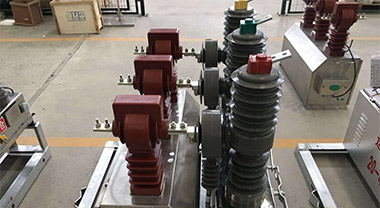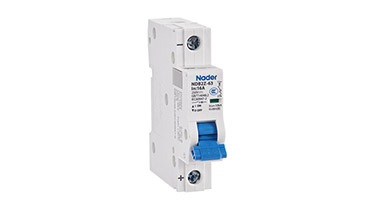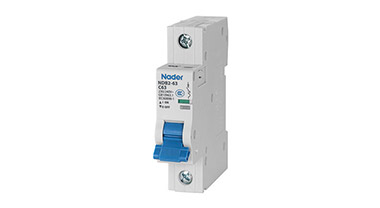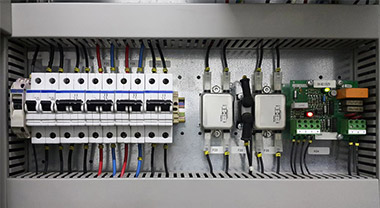Why does the circuit breaker trip?
There are generally three reasons for the circuit breaker at home to trip. The first is overload, the second is short circuit, and the third is leakage.
1. Overload is that too many high-power electrical appliances are using more than the rated current of the circuit breaker at the same time. It is estimated that you can't calculate it, so you can try a few less.
2. The short circuit may be a short circuit of a certain electrical appliance, or a short circuit of a hidden wire. If you don’t plug in any electrical appliances, you should consider the line short circuit. Of course, if it is a switch with leakage protection, there may be leakage. .
3. If it is a switch with leakage protection, the circuit or electrical appliance will trip if there is a little leakage, generally 30mA.
If it is the first case, then switch on fewer electrical appliances and replace with a larger circuit breaker, provided that your circuit cannot be too thin, and should be larger than the rated capacity of the circuit breaker.
If it is the second case, there is a short circuit inside an electrical appliance, just repair the electrical appliance. If the hidden wiring is short-circuited, you must ask a professional to check it.
If it is the third case, a certain electrical leakage, then plug in one electrical one one by one to turn it on and try it. When it comes to the one that jumps, it is the electrical fault. If there is electrical leakage in the hidden line, non-professionals cannot find out. Yes, just change to a switch without leakage protection, but one less safety protection.
Remarks: The switch with leakage protection has one more block next to the ordinary switch, which is wider. There is a small button on the switch with leakage protection. You can distinguish which type you belong to by observing it by yourself. If you suspect that there is a short-circuit fault in the hidden wire, directly use the resistance file of a multimeter to check the resistance of the phase wire to the neutral wire and the ground wire. Generally, there are electrical appliances, lights and other electrical appliances in the home. It is best to completely disconnect all the electrical appliances. At this time, the phase wire is to the neutral wire. The resistance should be large, theoretically infinite. If the resistance is less than a few ohms, it should be a short circuit. If you suspect that there is a leakage fault, the multimeter may not be able to detect it. It is best to use a shaker to insulate the phase wire from the ground. The national standard stipulates that it should not be less than 0.5M. In fact, leakage current is not unusable, but it is not possible to install a circuit breaker with leakage protection. In this way, if a person gets an electric shock, the protection will not be tripped. This is okay. As long as all electrical enclosures are grounded, the circuit breaker will trip protection once the enclosure is live. (Be sure to note that the ground wire mentioned here refers to the ground wire of the connection system. It does not allow you to keep the ground wire of the electrical enclosure in the ditch or bury it on the ground. Then it becomes a TT system, only the circuit breaker in the TN system Can be reliably protected)
Recently, I often receive calls from customers about the circuit breaker tripping problem. Mainly some universal circuit breakers, such as DW series circuit breakers, have tripped, and they cannot be closed automatically or manually. I consulted the engineers of the factory, and at the same time consulted some related materials, I will summarize here. However, it should be noted that there are many reasons for tripping, which cannot be applied to all situations. The list is also some of the most common ones, mainly for universal circuit breakers.
Generally speaking, after a trip occurs, the first thing to do is not to contact for inspection or maintenance immediately, but to first determine whether it is a false trip. If the current and voltage fluctuate for no reason, it is likely to be a malfunction of the circuit breaker's operating structure.
After it is clear that the circuit breaker has indeed tripped, the cause should be investigated. Generally speaking, there are two main reasons for circuit breaker tripping. The first type is short circuit. Such as in a humid environment is prone to similar situations. I remember a customer reported that a DW16-2500 universal circuit breaker appeared to be normal in sunny days and often tripped in rainy days, which was caused by a short circuit. Finally, it was checked that the control circuit was short-circuited, which caused the second incoming wire to burn and cause a trip.
The second type of reason is the load. For a simple example, if the current of the circuit is 200A and the frame current of the circuit breaker is only 100A, when the motor is connected, the circuit is normal, but the circuit breaker is obviously overloaded. Will cause the circuit breaker to keep tripping. Regarding load tripping, the most common thing is that in our daily life, the leakage circuit breaker (such as DZ47le-32 leakage circuit breaker) caused by excessive current trips. Generally speaking, tripping based on load should not happen, and parameters such as the rated current of the line should be known when selecting the model. Here is also a little knowledge: if the circuit breaker trips at the moment of starting, it is caused by a short circuit. Tripping during startup is caused by overload.
After analyzing the two types of reasons for circuit breaker tripping, some common analysis and treatment methods are summarized. The first is to determine whether it is a circuit problem or a circuit breaker problem. The general process is:
Observe whether the primary circuit is burnt, whether there is a peculiar smell, and whether the secondary control circuit in the low-voltage cabinet is faulty
1. When there is a fault point, it means that it is a circuit problem and has nothing to do with the circuit breaker.
2. There is no obvious fault point, and the circuit breaker cannot be closed even when there is no load, it means that the circuit breaker cannot be put into operation after tripping, which is a problem of the circuit breaker itself.
Generally, the circuit is easy to solve, but if it is a circuit breaker problem, further inspection is needed. The possible reasons are: mechanical system failure, free release wear, operating mechanism failure, etc. Here are two situations:
A. Ground fault trip (ground fault indicator light is on) processing method is to check the breaking current value and action time of the trip unit. If it is confirmed that there is a ground fault, it should be found and eliminated immediately. If there is no ground fault, check whether the ground fault current setting is appropriate, if the setting is not appropriate, modify the ground fault current setting.
B. The general solution for undervoltage release trip and mechanical interlock action is: check whether the power supply is lower than 70% Ue and whether the undervoltage release and control unit are faulty.
There are many reasons why the circuit breaker cannot be closed after tripping. For example, the undervoltage release fails to close and the circuit breaker cannot be closed because the voltage is too low or the undervoltage release coil loses power, which will result in the failure to reclose. On the topic of not being able to close, I will explain in detail in a later article. Some of the statements in the article are just a summary of experience and cannot solve all problems. If there is a problem, it is best to ask an experienced engineer to solve it or contact the corresponding manufacturer.




